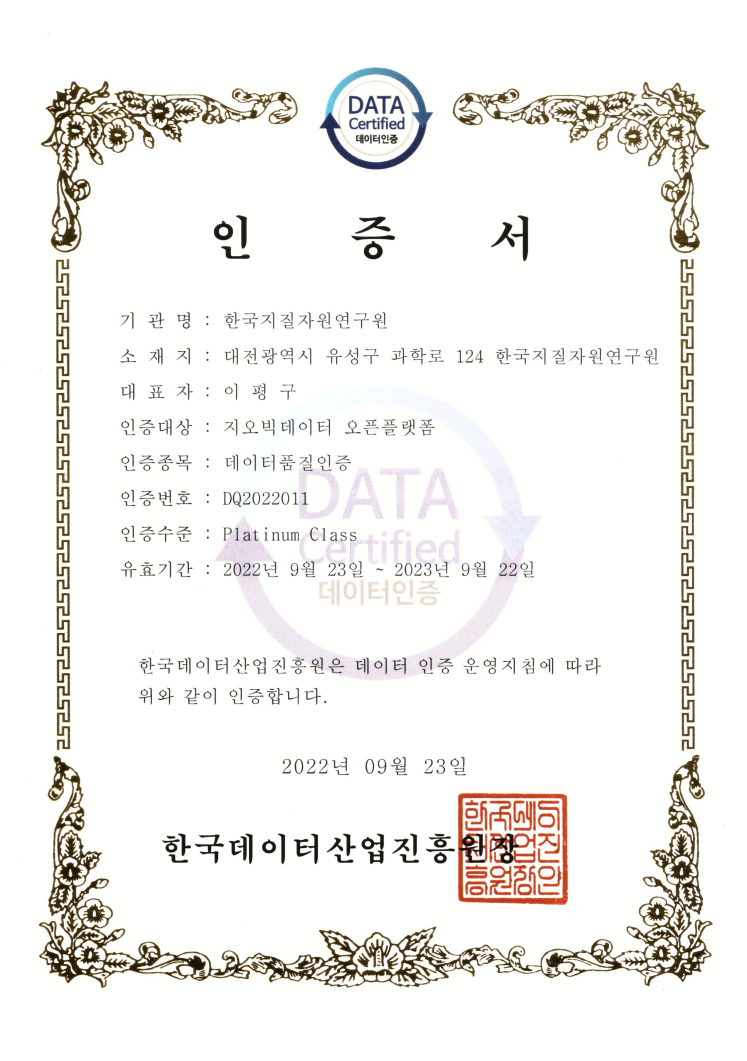경주 오도리 부채꼴 주상절리의 독특한 용암 지형
Data Quality Certification (DQC-V)

| Data type | KIGAM 보고서 |
|---|---|
| Title | 석유자원연구 [1998] (I) |
| Author | 정태진 |
| Language | KOR |
| Call Number | KR-98-C-33-1998-R |
| Publication Information | 韓國資源硏究所, 1998 |
| Abstract | 군산분지의 석유자원 평가 연구: Kunsan Basin is mainly filled with Creataceous and Tertiary clastic sediments, and divided into Southwest Sub-basin, Central Sub-basin and Northeast Sub-basin by uplifts and faults developed in the basin. Microfossils were studied for the biostratigraphic works of drill wells in the Kunsan Basin. The microfossils include organic-walled microfossils such as spores, pollen and nonmarine dinoflagellates and calcareous microfossils such as ostracods, charophytes and gastropods. The fossil assemblages of the Kunsan Basin reveal nonmarine environments ranging from alluvial fan to shallow lacustrine and climatic variation between subtropical and cool temperate temperature in the arid/humid alternating conditions. According to the paleontological data, the Kunsan Basin was initiated in the Early Cretaceous and expanded during Paleogene followed by regional erosion at the closing time of Paleogene on which Neogene sediments have been accumulated. The Paleogene strata show laterally irregular thickness in each Epoch due to migrating depocenter.Sediments penetrated by the wells were deposited in fluvial environment under repeated dry and wet climates. Lacustrine facies are formed in the shallow lake or swamp environment. The potential reservoirs in the Kachi-1 well are Cretaceous fluvial sandstones developed in interval between 2,021m-2,017m and 1,592m-1,587m. The major potential reservoir in Haema-1 is the Eocene sandstone in the interval between 1,665m-1,580m and secondary potential reservoir is the Paleocene sandstone in the interval between 2,325m-2,240m. The best potential reservoir in the IIH-1Xa well is Eocene fluvial sandstone in the interval between 1,978m-1,969m. The potential reservoir in the IIH-1X well is Paleocene sandstones developed in the intervals between 1,690m-1,680m and 1,935m-1,890m. The potential reservoir in the Inga-1 well is the Oligocene sandstone in the interval between 1,814 m-1,768m.... 육상 함유가능분지 해석연구 - 합천지역 1차년도-: The Cretaceous Gyeongsang Supergroup consists of more than 9km sequences of sedimentary and volcanic rocks in Hapchon-Changyong-Euiryong-Haman area and occupies the middle part of the Milyang subbasin. The Supergroup can be divided into three group; Sindong, Hayang and Yuchon groups in ascending order. Based on rock color, the Sindong Group can be subdivided into Nakdong, Hasandong and Jinju Formations. The Hayang Group can be subdivided into Chilgok, Silla Conglomerate, Haman and Jindong Formations. The Chilgok Formation includes basaltic lava and tuffs in the upeer part. The Haman Formation has Kusandong tuff (keybed) in the uppermost part in the Changyong area, whereas the tuff is intercalated below the volcaniclastics in the Haman area. The Sindong Group is represented by and alluvial fan (Nakdong and Hasandong Formations) and fan-delta (Hasandong and Jinju Formation) system in which the fan apex may have located near the Wugogri and Banggogri, Yongjumyun, Hapchungun. Sandstones of the Nakdong and Hasandong Formation were deposited in braided stream environment, whereas the dark gray and reddish mudstones were deposited in floodplains of a large-scale alluvial fan. The alluvial fan prograded into shallow lacustrine environment (Jinju Formation), in which the sandstones were deposited in braided stream and depositional lobes of a fan-delta. The Chilgok and Haman Formation are represented by thick red, greenish gray and dark gray mudstones, deposited in floodplain environment. Variation in climate may be responsible for the diverse color. The Silla Conglomerate were deposited in braided streams of an alluvial fan, whereas the thick, dark gray and black mudstones (Jindong Formation) were deposited in lacustrine environment.Sandstone of the Sindong and Hayang Groups belong to the quartz arenite to subarkose, and arkose to lithic arenite respectively. In Sindong Group, Sandstones are domainated by quartz grains except the upper part of the Jinju Formation. In the Hayang Group, however, feldspathic and tuffaceous sandstones are abundant. Sand grains are subangular to subrounded and moderately sorted, and show chiefly long contact. Primary pores are filled with diagenetic minerals such as calcite, silica and authigenic clay minerals. Dissolution of calcite and feldspar alteration form the minor secondary pores. Reservoir qualities of the sandstones are poor with less than 5% of porosity. Illite crystallinity values correspond to diagenesis or anchizone. The values in the anchizone are thought to be caused by intrusion |
| Page | 285 p. |
| Keyword | 석유, 석유자원, 군산, 군산분지, 육상, 함유가능, 분지, 합천, 층서, 퇴적, 고생물, 저유층, 퇴적암석학 |
| Source |
Comments